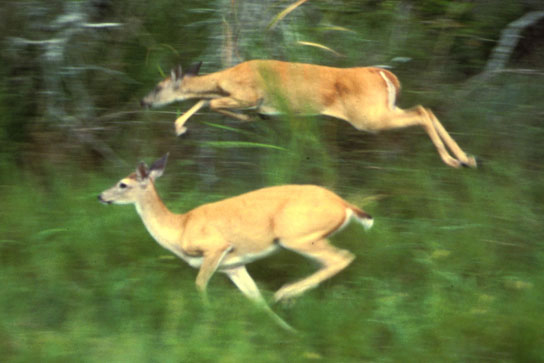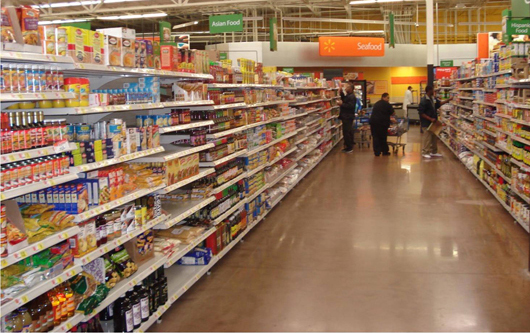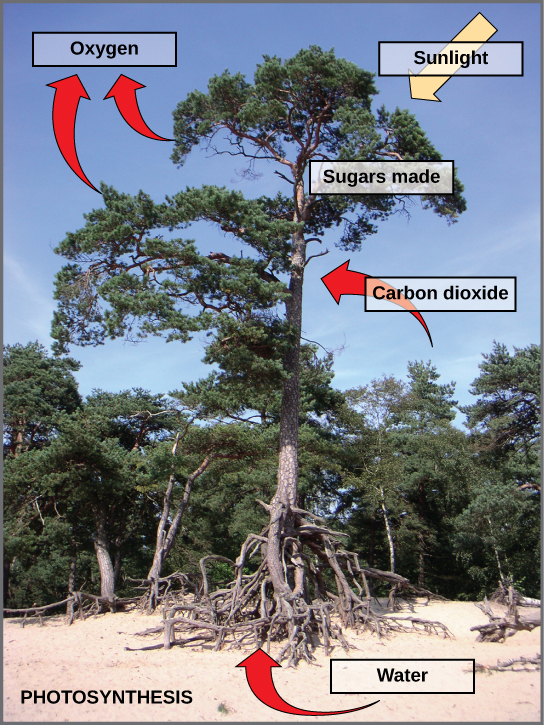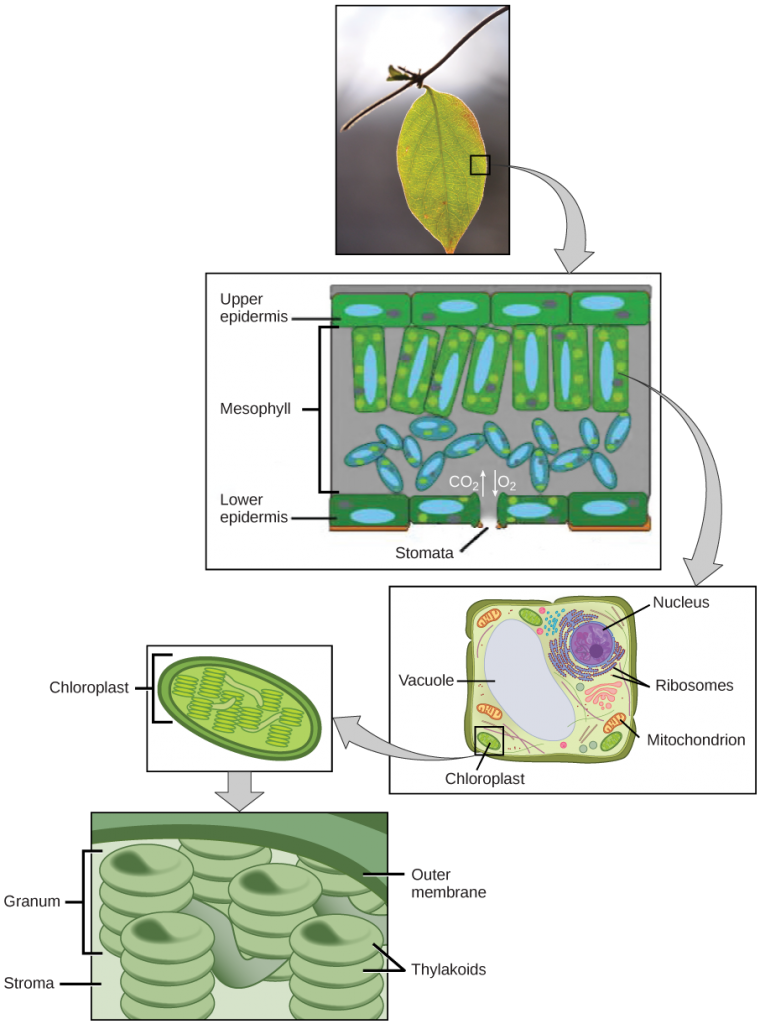6.1 Overview of Photosynthesis
Learning Objectives
By the end of this section, you will be able to:
- Summarize the process of photosynthesis
- Explain the relevance of photosynthesis to other living things
- Identify the reactants and products of photosynthesis
- Describe the main structures involved in photosynthesis
The energy that is harnessed from photosynthesis enters the ecosystems of our planet continuously and is transferred from one organism to another. Therefore, directly or indirectly, the process of photosynthesis provides most of the energy required by living things on earth.
Photosynthesis also results in the release of oxygen into the atmosphere. In short, to eat and breathe, humans depend almost entirely on the organisms that carry out photosynthesis.
Solar Dependence and Food Production
Some organisms can carry out photosynthesis, whereas others cannot. An autotroph is an organism that can produce its own food. The Greek roots of the word autotroph mean “self” (auto) “feeder” (troph). Plants are the best-known autotrophs, but others exist, including certain types of bacteria and algae (Figure 6.1). Oceanic algae contribute enormous quantities of food and oxygen to global food chains. Plants are also photoautotrophs, a type of autotroph that uses sunlight and carbon from carbon dioxide to synthesize chemical energy in the form of carbohydrates. All organisms carrying out photosynthesis require sunlight.

Heterotrophs are organisms incapable of photosynthesis that must therefore obtain energy and carbon from food by consuming other organisms. The Greek roots of the word heterotroph mean “other” (hetero) “feeder” (troph), meaning that their food comes from other organisms. Even if the food organism is another animal, this food traces its origins back to autotrophs and the process of photosynthesis. Humans are heterotrophs, as are all animals. Heterotrophs depend on autotrophs, either directly or indirectly. Deer and wolves are heterotrophs. A deer obtains energy by eating plants. A wolf eating a deer obtains energy that originally came from the plants eaten by that deer. The energy in the plant came from photosynthesis, and therefore it is the only autotroph in this example (Figure 6.2). Using this reasoning, all food eaten by humans also links back to autotrophs that carry out photosynthesis.

BIOLOGY IN ACTION
Photosynthesis at the Grocery Store

Major grocery stores in British Columbia are organized into departments, such as dairy, meats, produce, bread, cereals, and so forth. Each aisle contains hundreds, if not thousands, of different products for customers to buy and consume (Figure 6.3).
Although there is a large variety, each item links back to photosynthesis. Meats and dairy products link to photosynthesis because the animals were fed plant-based foods. The breads, cereals, and pastas come largely from grains, which are the seeds of photosynthetic plants. What about desserts and drinks? All of these products contain sugar—the basic carbohydrate molecule produced directly from photosynthesis. The photosynthesis connection applies to every meal and every food a person consumes.
Main Structures and Summary of Photosynthesis
Photosynthesis requires sunlight, carbon dioxide, and water as starting reactants (Figure 6.4). After the process is complete, photosynthesis releases oxygen and produces carbohydrate molecules, most commonly glucose. These sugar molecules contain the energy that living things need to survive.

The complex reactions of photosynthesis can be summarized by the chemical equation shown in Figure 6.5.

Although the equation looks simple, the many steps that take place during photosynthesis are actually quite complex, as in the way that the reaction summarizing cellular respiration represented many individual reactions. Before learning the details of how photoautotrophs turn sunlight into food, it is important to become familiar with the physical structures involved.
In plants, photosynthesis takes place primarily in leaves, which consist of many layers of cells and have differentiated top and bottom sides. The process of photosynthesis occurs not on the surface layers of the leaf, but rather in a middle layer called the mesophyll (Figure 6.6). The gas exchange of carbon dioxide and oxygen occurs through small, regulated openings called stomata.
In all autotrophic eukaryotes, photosynthesis takes place inside an organelle called a chloroplast. In plants, chloroplast-containing cells exist in the mesophyll. Chloroplasts have a double (inner and outer) membrane. Within the chloroplast is a third membrane that forms stacked, disc-shaped structures called thylakoids. Embedded in the thylakoid membrane are molecules of chlorophyll, a pigment (a molecule that absorbs light) through which the entire process of photosynthesis begins. Chlorophyll is responsible for the green color of plants. The thylakoid membrane encloses an internal space called the thylakoid space. Other types of pigments are also involved in photosynthesis, but chlorophyll is by far the most important. As shown in Figure 6.6, a stack of thylakoids is called a granum, and the space surrounding the granum is called stroma (not to be confused with stomata, the openings on the leaves).
The Two Parts of Photosynthesis
Photosynthesis takes place in two stages: the light-dependent reactions and the Calvin cycle. In the light-dependent reactions, which take place at the thylakoid membrane, chlorophyll absorbs energy from sunlight and then converts it into chemical energy with the use of water. The light-dependent reactions release oxygen from the hydrolysis of water as a by-product. In the Calvin cycle, which takes place in the stroma, the chemical energy derived from the light-dependent reactions drives both the capture of carbon in carbon dioxide molecules and the subsequent assembly of sugar molecules. The two reactions use carrier molecules to transport the energy from one to the other. The carriers that move energy from the light-dependent reactions to the Calvin cycle reactions can be thought of as “full” because they bring energy. After the energy is released, the “empty” energy carriers return to the light-dependent reactions to obtain more energy.
EVOLUTION IN ACTION
Pathways of Photosynthesis and Cellular Metabolism
Photosynthesis and cellular metabolism consist of several very complex pathways. It is generally thought that the first cells arose in an aqueous environment—a “soup” of nutrients. If these cells reproduced successfully and their numbers climbed steadily, it follows that the cells would begin to deplete the nutrients from the medium in which they lived, as they shifted the nutrients into their own cells. This hypothetical situation would have resulted in natural selection favoring those organisms that could exist by using the nutrients that remained in their environment and by manipulating these nutrients into materials that they could use to survive. Additionally, selection would favor those organisms that could extract maximal value from the available nutrients.
An early form of photosynthesis developed that harnessed the sun’s energy using compounds other than water as a source of hydrogen atoms, but this pathway did not produce free oxygen. It is thought that glycolysis developed prior to this time and could take advantage of simple sugars being produced, but these reactions were not able to fully extract the energy stored in the carbohydrates. A later form of photosynthesis used water as a source of hydrogen ions and generated free oxygen. Over time, the atmosphere became oxygenated. Living things adapted to exploit this new atmosphere and allowed respiration as we know it to evolve. When the full process of photosynthesis as we know it developed and the atmosphere became oxygenated, cells were finally able to use the oxygen expelled by photosynthesis to extract more energy from the sugar molecules using the citric acid cycle.
Section Summary
The process of photosynthesis transformed life on earth. By harnessing energy from the sun, photosynthesis allowed living things to access enormous amounts of energy. Because of photosynthesis, living things gained access to sufficient energy, allowing them to evolve new structures and achieve the biodiversity that is evident today.
Only certain organisms, called autotrophs, can perform photosynthesis; they require the presence of chlorophyll, a specialized pigment that can absorb light and convert light energy into chemical energy. Photosynthesis uses carbon dioxide and water to assemble carbohydrate molecules (usually glucose) and releases oxygen into the air. Eukaryotic autotrophs, such as plants and algae, have organelles called chloroplasts in which photosynthesis takes place.
Exercises
Glossary
autotroph: an organism capable of producing its own food
chlorophyll: the green pigment that captures the light energy that drives the reactions of photosynthesis
chloroplast: the organelle where photosynthesis takes place
granum: a stack of thylakoids located inside a chloroplast
heterotroph: an organism that consumes other organisms for food
light-dependent reaction: the first stage of photosynthesis where visible light is absorbed to form two energy-carrying molecules (ATP and NADPH)
mesophyll: the middle layer of cells in a leaf
photoautotroph: an organism capable of synthesizing its own food molecules (storing energy), using the energy of light
pigment: a molecule that is capable of absorbing light energy
stoma: the opening that regulates gas exchange and water regulation between leaves and the environment; plural: stomata
stroma: the fluid-filled space surrounding the grana inside a chloroplast where the Calvin cycle reactions of photosynthesis take place
thylakoid: a disc-shaped membranous structure inside a chloroplast where the light-dependent reactions of photosynthesis take place using chlorophyll embedded in the membranes
Media Attributions
- Figure 6.1 (a): Steve Hillebrand, U.S. Fish and Wildlife Service; (b): “eutrophication&hypoxia”/Flickr; (c): NASA; scale-bar data from Matt Russell
- Figure 6.2 by Steve VanRiper, U.S. Fish and Wildlife Service
- Figure 6.3 by Associação Brasileira de Supermercados
- Figure 6.6 modification of work by Cory Zanker



